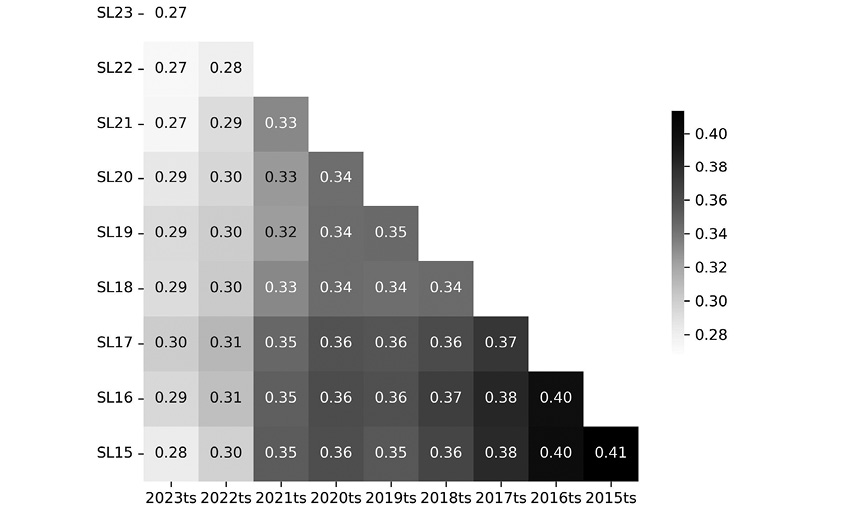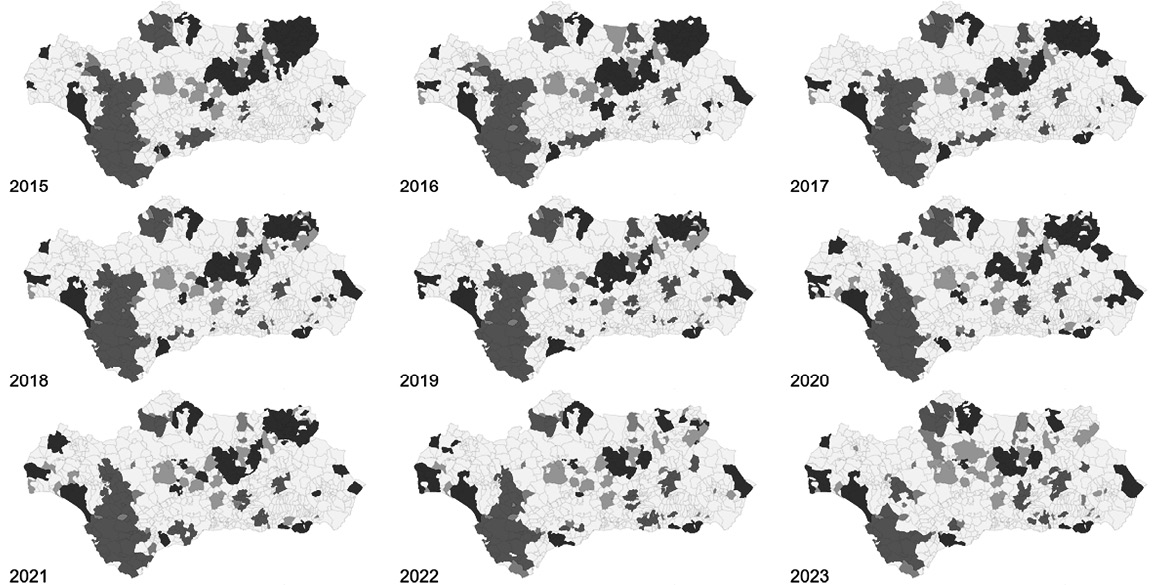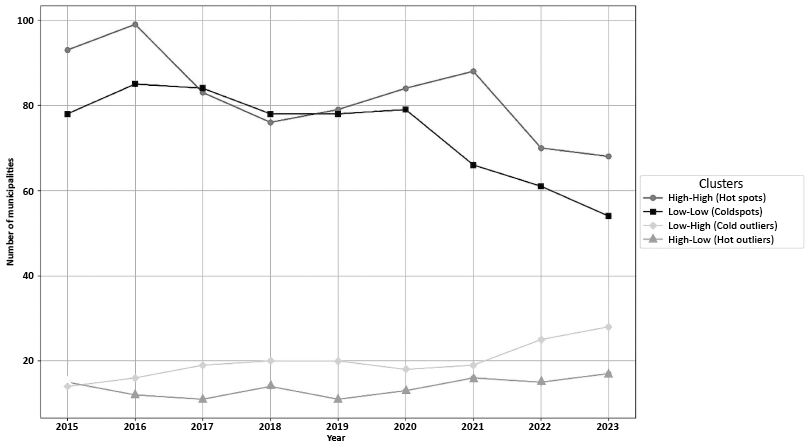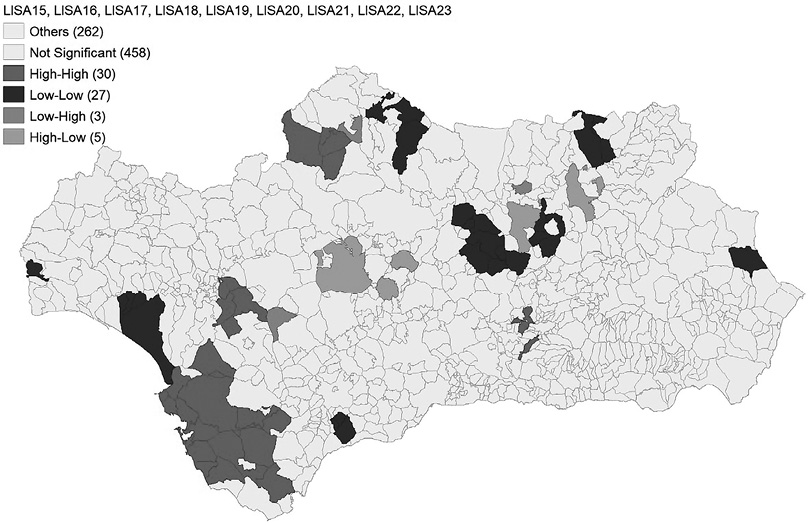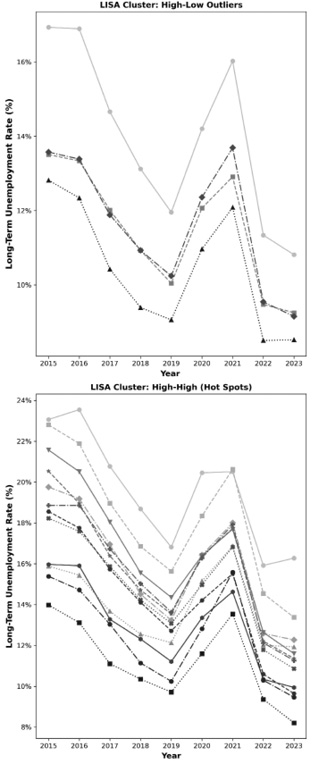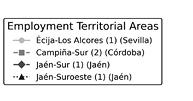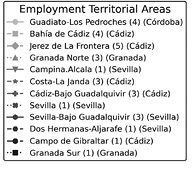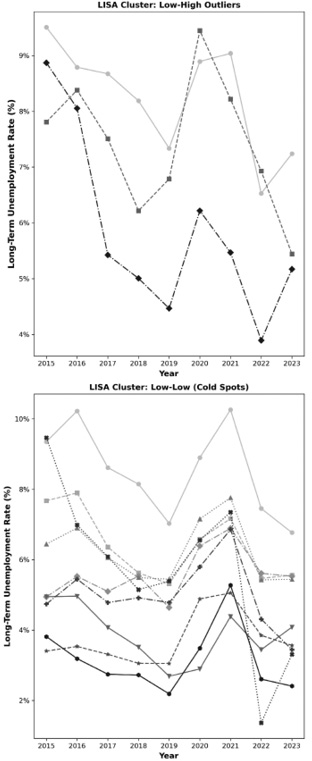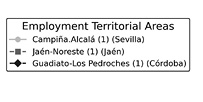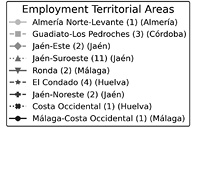Long-term Unemployment in Andalusia:
A Geo-sociological Analysis of Spatio-temporal Patterns
Desempleo de larga duración en Andalucía: análisis geosociológico
de patrones espaciotemporales
Antonio Jesús Acevedo-Blanco, Violante Martínez-Quintana
and Miryam C. González-Rabanal
|
Key words Andalusia
|
Abstract This research used open data from 2015 to 2023 to analyse the spatio-temporal dependence of long-term unemployment (LTU) at the municipal level in Andalusia, Spain, and its geo-sociological significance. A bivariate spatial analysis was conducted to assess global dependence, followed by an approach to assess local autocorrelation using a LISA (Local Indicators of Spatial Association) cluster analysis and a colocation map of the clusters over the time series. The results revealed a decrease in spatial autocorrelation and a significant reduction in the territorial polarisation of LTU, suggesting possible improvements in employment. The practical implications highlighted the importance of including spatial data science and open data in territorially-focused employment policies to adequately assess the ensuing socio-economic and employment implications. |
|
Palabras clave Andalucía
|
Resumen Esta investigación analiza la dependencia espaciotemporal del desempleo de larga duración (DLD) a nivel municipal en Andalucía y su significación geosociológica, utilizando datos abiertos de 2015 a 2023. Se lleva a cabo un análisis espacial bivariante para evaluar la dependencia global, seguido de una aproximación a la autocorrelación local mediante el análisis de clúster LISA (Local Indicators of Spatial Association) y un mapa de colocalización de las agrupaciones en la serie temporal. Los resultados revelan un descenso en la autocorrelación espacial y una reducción significativa de la polarización territorial del DLD, lo que sugiere posibles mejoras en el empleo. Las implicaciones prácticas destacan la importancia de incluir las ciencias de datos espaciales y los datos abiertos en políticas de empleo territorialmente focalizadas, para evaluar adecuadamente las implicaciones socioeconómicas y laborales. |
Citation
Acevedo-Blanco, Antonio Jesús; Martínez-Quintana, Violante; González-Rabanal, Miryam C. (2025). “Long-term Unemployment in Andalusia: A Geo-sociological Analysis of Spatio-temporal Patterns”. Revista Española de Investigaciones Sociológicas, 192: 5-26. (doi: 10.5477/cis/reis.192.5-26)
Antonio Jesús Acevedo-Blanco: Universidad Nacional de Educación a Distancia | aacevedo13@alumno.uned.es
Violante Martínez-Quintana: Universidad Nacional de Educación a Distancia | vmartin@poli.uned.es
Miryam C. González-Rabanal: Universidad Nacional de Educación a Distancia | mcgonzalez@cee.uned.es
Introduction1
Unemployment, and in particular, long-term unemployment (LTU), is a critical social issue with significant impact across several regions of the European Union (EU), which has escalated to become a social emergency in the Autonomous Community of Andalusia, Spain. This article analyses long-term unemployment in Andalusia between 2015 and 2023 from a spatio-temporal perspective, using official open data disaggregated at the municipal level.
It is imperative to begin by establishing a definition of unemployment and how the social category of “unemployed” is constructed (Plugiese, 2000). This conceptual exercise first involves identifying individual unemployment status, which commences with the voluntary registration of individuals at employment offices as jobseekers, that is, through the active search for work. This registration enables the subsequent collection of statistical data, which, in line with European unemployment measurement criteria, classifies a person as long-term unemployed when they have been registered as a jobseeker for more than one year.
The complexity and intersectional nature of long-term unemployment (Aldrich et al., 2020) demand a multidisciplinary approach. The analysis of LTU must consider both personal factors—such as mental health, family dynamics, age, socioeconomic status and job skills—and elements pertaining to social structures—such as the economic context and the local labour market which the unemployed person navigates (Fernández-Marín, Riquelme-Perea and López-Martínez, 2020). It is therefore particularly important for social research on LTU to address the phenomenon within a defined spatial and socio-economic context, where local labour markets play a regulatory role in employment dynamics (Prieto Rodríguez, 2024; Manzanares-Gutiérrez and Riquelme-Perea, 2017).
However, this “context-sensitive” perspective on social and economic facts has not always been considered in social research. Urry (2001) emphasised that neglecting the spatial dimension in theoretical frameworks has hindered our ability to gain a comprehensive understanding of societies and their interactions. This has resulted in an “aspatial” view of societies whereby they have come to be treated as self-contained entities with fixed internal structures, thus overlooking the importance of spatial variations within and between societies, states and administrative boundaries. Díaz Parra and Roca (2021) advocated for the need to include space in the explanatory models of the social sciences, as failing to heed them in sociological theories limits the understanding of how physical environment shapes social interactions and how power relations are articulated through the spatial organisation of society (Soja, 2022).
Kesteloot, Loopmans and Decker (2009) noted that, in contrast, the Chicago School has been instrumental in establishing the “context-sensitive” paradigm, stressing the relevance of the physical and geographical context in sociological analysis. For Abbott (1997), social phenomena are intrinsically linked to their spatial and temporal contexts. Porter (2011) suggested that there is a need to develop a theoretical framework that fosters the development of “geo-sociological imaginations”, based on technological advances and the processing of large volumes of geo-referenced data (Gutiérrez-Puebla and García-Palomares, 2016; Lee and Kang, 2015). This orientation would facilitate a more profound understanding of spatial relations within sociology. In line with this methodological perspective, the approach that incorporates the spatial dimension into the analysis of social and economic phenomena is supported by the current paradigm of spatially integrated social sciences (Garrocho, 2016). This paradigm advocates for the convergence of disciplines such as sociology, geography, data science and economics, offering a geographically integrated understanding of social phenomena (Rodrigues-Silveira, 2013).
Following this theoretical framework, this research focuses on examining LTU in Andalusia at the municipal level, employing official statistical sources with open data and relying on a spatio-temporal approach that goes beyond the traditional geographical disaggregation of the Labour Force Survey (LFS). Spatial Data Analysis (SDA) (Anselin, 1996) was used to examine the spatial dependence of the phenomenon at both local and global levels, assessing the correlation of LTU across space and time.
The main objectives of this research are structured around the following hypotheses:
- Hypothesis 1 (H1): To explore the spatial correlation between unemployment rates in previous (t-1) and current (t) periods using the bivariate Moran’s I statistic. This procedure examines how LTU rates in nearby locations in the past influence the current unemployment rate in a given location.
- Hypothesis 2 (H2): To assess the spatial autocorrelation of long-term unemployment (LTU) over the period 2015-2023 using local Moran’s I. To achieve this objective, the local spatial dependence of LTU will be analysed using the LISA (Local Indicators of Spatial Association) cluster colocation method. This procedure will identify temporal trends indicating increases or decreases in clusters of municipalities with similar indicator values; in other words, geographical clusters of long-term unemployment.
The article is structured into several sections. The first section reviews the literature, presenting current social research on long-term unemployment and the spatial dependence of unemployment in municipal or local labour market contexts. The second section is a methodological section that details the calculation of the indicator, the open data sources used and the operational basis of Moran’s spatial autocorrelation algorithms. The third section, focused on results and discussion, identifies clusters with higher or lower incidence of long-term unemployment and shows a trend towards an attenuated polarisation of LTU. Finally, the conclusions highlight the spatio-temporal dependence of LTU and its practical implications. Emphasis is made on the need to adjust employment policies in the Autonomous Community of Andalusia in order to address the specific characteristics of each area and avoid uniform approaches that fail to take territorial differences into account. The use of spatial data science in statistical modelling (Sánchez López, 2023) is proposed to support public planning of employment plans.
A theoretical review and related empirical research background
The importance of work in capitalist society and the impact of job loss transcend individual psychosocial repercussions (Bonna, 2021). Systemic employment crises have increased the average length of unemployment, exacerbating its individual and social impacts, particularly those associated with long-term unemployment (LTU) (Laliberte Rudman and Aldrich, 2016). This situation has significant implications for individuals, states and regions, including social marginalisation and territorial stigmatisation based on negative perceptions of dependence. The ensuing financial insecurity hampers economic growth (Theurl and Tamesberger, 2021), deepens social isolation, and negatively affects both employability and overall well-being (Lindsay, 2010).
International research on the causes of LTU has identified several determinants, including gender, age, educational level, previous work experience and family responsibilities. In addition, high vulnerability to unemployment can be seen in specific regions, especially among women and people working in the informal sector. This vulnerability is more pronounced among those with basic educational attainment and employed by microenterprises in the service sector (Ortiz Lazcano and Rodríguez Esparza, 2022). This means that women and minorities are more likely to be underemployed or outside the labour force compared to men (Grzenda, 2019; Jaba et al., 2010).
Moreover, a macroeconomic level analysis shows that the consequences of LTU are equally deleterious, as it leads to reduced productivity (Ladňáková and Špániková, 2020); raises social welfare expenditure; and may hinder economic growth, since it results in the opportunities offered by technological advances and globalisation being missed, owing to skills mismatches and rigidities in labour markets. These repercussions also have an impact on local economies, where factors such as the presence or absence of key industries, economic orientation towards intensive tourism and investment shortages in infrastructure and transport can significantly influence local LTU rates (Livanos, 2007).
Studies such as that by Martínez-Quintana (2004) showed that the situation of the adult long-term unemployed requires an in-depth analysis of trends in inequality and social exclusion. She examined the situations faced by the long-term unemployed in relation to social exclusion and poverty, which have particularly affected women, individuals experiencing skill deterioration and people with disabilities who had managed to enter the labour market. Her conclusion was that barriers related to skill requirements, insufficient labour demand and labour market mismatches were additional obstacles encountered by those who experience long-term unemployment (Martínez-Quintana, 2011). These problems underline the need for a comprehensive and coordinated approach to effectively address protracted unemployment and its consequences (Bejaković and Mrnjavac, 2018).
LTU and Unobserved Heterogeneity. Spatial dependence of unemployment
The importance of investigating the reasons behind remaining unemployed for prolonged periods, addressing both “genuine state dependence” and “unobserved heterogeneity”, has been highlighted by several scholars, including Cutuli and Grotti (2020). For them, genuine state dependence refers to the propensity for certain individuals to remain unemployed for extended periods due to structural factors within the labour market, such as limited job opportunities, barriers to employment access or discrimination; whereas unobserved heterogeneity denotes differences among unemployed individuals which, despite not being captured by the variables available in a dataset, may significantly influence the outcomes. These differences may include individual attributes, such as innate abilities, motivation, personal preferences or social networks, as well as other contextual, geographical, local or residential attributes that are not normally quantified.
In particular, the relationship of unobserved heterogeneity between LTU and geographical context at the municipal level has not been explored in the literature and empirical research because of the lack of adequate indicators to carry out this level of analysis. However, the spatial dependence of unemployment has been extensively studied. In this context, this study used an inductive approach based on relevant theoretical contributions on unemployment and its spatial dependence, given the lack of indicators at the local level. This made it possible to focus on LTU and its relationship to spatial factors at the municipal level.
It is essential to consider that, although unemployment varies significantly by location, it is usually analysed from a statewide point of view. Nevertheless, there is a compelling reason to consider unemployment from a regional perspective: unemployment disparities between regions within countries are almost as large as unemployment disparities between countries themselves (Elhorst, 2003). Regional unemployment rates have a strong spatio-temporal correlation and may run parallel to or diverge from state unemployment rates. Ignoring serial dynamics, spatial dependence and common factors can lead to biased inferences about unemployment (Halleck Vega and Elhorst, 2016).
Using this approach, Al-Ayouty and Hassaballa (2020) examined regional unemployment in Egypt using spatial panel data analysis. Their findings revealed that the level of unemployment in a region is influenced by a number of factors (unobserved heterogeneity), such as climate conditions, quality of life, rental costs and educational opportunities. The results suggested that each region can have an idiosyncratic unemployment rate, determined by its unique set of endogenous conditions.
Focusing on Romania and Hungary, Dănăcică and Mazilescu (2014) highlighted the significant influence of geographical location on the duration of unemployment, noting that economic disparity between regions and the availability of job opportunities affected employment prospects and permanent long-term unemployment.
Studies on the spatial dependence of unemployment have shown that Exploratory Spatial Data Analysis (ESDA) methodology can be as effective as time series analysis, especially when applied to the study of unemployment with the aim of developing statistical models adapted to the particularities of each regional context. ESDA methodology has been successfully applied to the European socio-occupational field in several countries. In Italy, Cracolici, Cuffaro and Nijkamp (2007, 2009) used this technique to explore the spatial dynamics of unemployment. In Greece, Prodromídis (2012) centred the analysis on employability at the municipal level, differentiating between spatial and non-spatial factors affecting the employability of both men and women. In Poland, Lewandowska-Gwarda (2018a, 2018b) investigated women’s unemployment from a spatial perspective and highlighted how economic, social and demographic factors influence this phenomenon.
In the same vein, research by Patacchini and Zenou (2007) explored the spatial correlation between local unemployment rates in the UK, stressing the impact of commuting patterns and labour mobility. Furthermore, studies on the spatial patterns of unemployment in Central Europe and the Czech Republic (Netrdová and Blažek, 2019; Netrdová and Nosek, 2016) emphasised the importance of understanding these patterns for effective policy-making, employing tools similar to those used in this research, such as bivariate Moran’s I and LISA cluster analysis. These studies identified a trend towards convergence of unemployment rates at the municipal level in the Czech Republic since the onset of the economic crisis which resulted in the observation of what they called “convergence in misery”.
The specific nature of the labour market in Spain is notably complex, underscoring the necessity for employment policies that are tailored to the particular conditions of each local market. For example, Güell and Lafuente (2022) highlighted that labour market frictions in Spain are a key factor in understanding the variability in the duration of unemployment. They noted that the probability of finding employment varied over time, particularly affecting women and university graduates.
When examining variations in unemployment trends across the Spanish provinces, López-Bazo and Motellón (2017) associated these differences with worker characteristics and geographical factors. Their conclusions were consistent with those by Bentolila, García-Pérez and Jansen (2017), who emphasised the significant influence of demographic and social factors—such as age and educational attainment—on unemployment at the provincial level.
At the municipal level, notable studies have been conducted across various Autonomous Communities in Spain. One such study was that by Cidoncha, Cárdenas and Nieto (2023) on municipalities in Cantabria, which not only identified the most vulnerable areas but also provided valuable insights into how demographic and socio-economic factors influenced unemployment in that region. In the Autonomous Community of Madrid, Rodríguez Moya and Pozo Rivera (2019) carried out a disaggregated analysis of unemployment to examine the impact of socio-demographic variables on its spatial distribution. Meanwhile, Martínez-Tola and De la Cal (2017) explored unemployment in Basque Country municipalities during the economic crisis of 2007 to 2014 from both a territorial and gender perspective, and found that the crisis affected women and men differently. This approach highlighted the significance of incorporating gender as an analytical variable in the study of unemployment in order to achieve a more comprehensive understanding of its effects and dimensions.
Research related to gender as a factor connected to employment and unemployment in Andalusia has produced significant contributions that have brought to the fore the complexity and socio-labour heterogeneity of the region. According to the Argos Observatory (2024), 45.18 % of unemployed women registered in Andalusia had been seeking employment for over twelve months in 2023, while approximately 38.99 % had been doing so for less than six months. When analysing the time spent seeking employment in relation to the age of job seekers, the length of time registered as job seekers increased with age. Only 14.75% of women under 25 had been looking for a job for more than one year, a proportion which doubled (32.07 %) among women aged 25 to 44 and quadrupled (58.11 %) among women aged 45 and over. Furthermore, a comparison by gender showed that women tended to remain registered as job seekers for longer than men. While 38.23 % of unemployed men had been looking for a job for more than one year, this figure was seven percentage points lower than that of women (45.18 %).
Territorial gender research by Checa-Olivas (2021) and Chica-Olmo, Checa-Olivas and López-Castellano (2021) used a spatio-temporal approach to examine the distinctive characteristics of the gender employment gap in Andalusia, and found that both observable and unobservable factors contributed to its spatial distribution. They also suggested that employment policies implemented in one region could have significant effects on neighbouring regions through imitation, competition and learning mechanisms.
Some scholars, including Sánchez, Sánchez and Ruiz-Muñoz (2018), have analysed differences between municipalities of varying sizes in Andalusia, and in so doing have contributed to the broader spatial analysis at the municipal level. Their findings indicated that larger, more urbanised municipalities acted as the “labour engine” of the local labour market, as they showed greater resilience in times of financial crisis compared to smaller municipalities, which suffered a more severe impact from unemployment.
Applying a similar methodology, but resorting to advanced distance matrices, López-Hernández (2013) identified patterns of spatial dependence in unemployment rates in Andalusia, capturing both global and local spatial dependence. Using up-to-date data for all Andalusian municipalities, Acevedo-Blanco, Martínez-Quintana, and González-Rabanal (2023), along with Acevedo-Blanco and Martínez-Quintana (2021), offered a comprehensive analysis of how geographical context shapes both the distribution and intensity of unemployment, as well as the gender gap. This study underlined the need for a more granular approach that goes beyond state statistics, paying special attention to the specific spatial dynamics in Andalusia. These studies also identified areas with a high concentration of unemployment, especially in the provinces of Cádiz, Córdoba and Huelva, as well as in specific municipalities in Seville and Jaén. Clusters with a high incidence of gender gaps in unemployment, predominantly in rural areas, also stood out.
In summary, given that unemployment patterns can vary significantly between different territories (not only between countries, but also between Autonomous Communities, regions or municipalities), it is essential to carry out a disaggregated study at territorial level. This allows for a more accurate diagnosis of its causes and the design of better adapted policies to combat it. For this reason, analyses such as the one presented in this research on LTU are not only novel considering the scarcity of previous studies, but they are also valuable on account of the detailed information they can provide.
Methodology
This research is methodologically grounded in the ESDA approach, which combines spatial dependence statistics with spatio-temporal dependence analysis. Its main strength lies in its capacity to analyse large geographic databases without requiring prior knowledge of their spatial distribution. This methodology suggests using inductive research designs in which the variables of analysis are descriptive (statistical) rather than confirmatory (econometric) (Chasco and Fernández-Avilés, 2009).
The use of this methodology has been facilitated by the increasing access to locally disaggregated open data, both at state and international level, which has significantly boosted research into the spatial interactions of unemployment. This interest has been particularly noticeable among spatial data scientists and Open Government evidence-based policy-makers. Hence, various analysts have advocated for the use of empirical research to highlight the distinctive characteristics that help to understand the dynamics of regional labour markets (Kondo, 2015).
The contributions by Goodchild and Li (2021) were also taken into account in the study. These researchers proposed the concept of “weak replicability” to reflect that the ability to replicate studies is not absolute, due to the spatially heterogeneous phenomena observed within the geospatial sciences. This idea underlines the importance of localised research, especially to understand unemployment from a perspective that considers both the geographical particularities of each area and their sociological significance, as well as the spillover effect on neighbouring areas.
It should be noted that the analysis of unemployment statistics in Spain has traditionally been broken down at provincial level through the Labour Force Survey (EPA). However, thanks to advances in the management of large volumes of data, statistical institutes, including the Instituto de Estadística y Cartografía de Andalucía (Institute of Statistics and Cartography of Andalusia [IECA]), have started to offer open unemployment data based on administrative records. This methodology has provided disaggregated unemployment rates at the local level, although municipal rates of LTU had not been included among the indicators provided by these institutions to date.
The development of the ESDA methodology requires a series of processes that are undertaken over several successive stages. The steps and stages in our research are detailed in the following sections:
Calculation of the LTU municipal levy
IECA is currently developing the Sistema de Indicadores de Desarrollo Sostenible de Andalucía (Sustainable Development Indicators System for Andalusia) for the 2030 Agenda. The main objective of this system is to establish a framework of statistical indicators aligned with the standards defined by the United Nations and Eurostat, thereby facilitating the monitoring of the goals and targets of the 2030 Agenda for Sustainable Development at territorial level (IECA, 2024b).
In partnership with the Directorate-General for the Regions, Eurostat and the Joint Research Centre (JRC) of the European Commission, the IECA has developed an LTU indicator at municipal level. This indicator is based on the analysis of administrative records of unemployment provided by the Servicio Andaluz de Empleo (Andalusian Employment Service [SAE]), accessible through the ARGOS employment observatory, which reports to the Employment Department of the Andalusian Regional Government. The IECA’s own registers were also used, extracted from the register of Social Security affiliations (IECA, 2024a).
This indicator addresses the LTU municipal rate and is freely available to both researchers and the general public. It is calculated based on the ratio between jobseekers who have been unemployed for over a year and the total of these jobseekers plus those who are in employment in the same municipality. The municipal LTU rate is defined as the number of jobseekers not in employment (known by its Spanish acronym DENOS [demandantes de empleo no ocupados]) for more than one year per one hundred people in employment. To avoid double-counting of temporary agricultural workers receiving special unemployment benefits (trabajadores eventuales agrícolas subsidiados [TEAS]) who have been seeking employment for over a year (Acevedo-Blanco and Martínez-Quintana, 2022), the calculation is adjusted by subtracting this group from the total. The indicator is updated annually, based on the yearly average of people out of employment, people registered as being in employment and TEAS seeking employment at the end of each quarter.
Local and global spatial dependence of LTU in Andalusia
The Moran’s I statistic is one of the most widely used tools in the exploratory assessment of spatial autocorrelation of geo-referenced socio-economic data (Moran, 1950). This statistic measures the correlation between a spatially intensive variable and its weighted average in neighbouring locations. It works similarly to a Pearson correlation coefficient: a positive spatial autocorrelation indicates that the values of the variable at one location will be similar to the values of its neighbours, while a negative spatial autocorrelation indicates unequal values in neighbouring locations.
The procedure begins by introducing a contiguity matrix to identify the neighbourhood relationships between spatial objects. The connectivity defining the neighbourhood is incorporated into the spatial weights W matrix, representing the spatial objects in each row i. In turn, the matrix contains elements corresponding to the same locations also represented in the columns j. The structure of Wij identifies locations neighbouring a given location, such that values = 1 represent “neighbours” and values = 0 refer to “non neighbours”.

The form of Moran’s I for each location i is as follows:

Where m represents the variance; and z represents deviations from the mean  . The sum of all Local Moran’s I values forms the Global Moran’s I statistic.
. The sum of all Local Moran’s I values forms the Global Moran’s I statistic.

The global spatial dependence that can be shown by Global Moran’s I does not detect the significance of local locations. For this purpose, Anselin (1995) developed the Local Moran’s I algorithm together with its graphical representation, or LISA map. The algorithm  calculates a statistic for each of the spatial locations to check whether there was a significant association of analogous values (high or low) in each unit i as follows:
calculates a statistic for each of the spatial locations to check whether there was a significant association of analogous values (high or low) in each unit i as follows:

Where  and
and  are the values of variable
are the values of variable  taken in deviations from the mean at locations
taken in deviations from the mean at locations  refers to the spatial weights matrix,
refers to the spatial weights matrix,  outlines a constant proportionality factor across all spatial units, and
outlines a constant proportionality factor across all spatial units, and  refers to the set of units related to
refers to the set of units related to  . The result shows that the mean of the values of
. The result shows that the mean of the values of  will be equal to the mean of
will be equal to the mean of  times the proportionality factor.
times the proportionality factor.
Bivariate Moran’s I. A spatio-temporal perspective
A special case of bivariate spatial autocorrelation occurs when the variable is measured at two points in time, say  . The statistic then refers to the degree to which the value observed at one location at a given time correlates with its value at neighbouring locations at a different time.
. The statistic then refers to the degree to which the value observed at one location at a given time correlates with its value at neighbouring locations at a different time.
The intuitive explanation of this concept associates  with
with  , which represents the connection between a present value
, which represents the connection between a present value  and the values of its neighbours at a previous time,
and the values of its neighbours at a previous time,  . Here, “y” is the spatial lag of the unemployment rate, which reflects the unemployment rate at nearby locations at time
. Here, “y” is the spatial lag of the unemployment rate, which reflects the unemployment rate at nearby locations at time  . Meanwhile, “x” refers to the current adjusted and standardised unemployment rate at time t for the specific location under analysis.
. Meanwhile, “x” refers to the current adjusted and standardised unemployment rate at time t for the specific location under analysis.

Results and discussion
Bivariate Moran’s I
To systematically assess the variation of the Moran’s Index over time, we implemented the calculation of the bivariate Moran Index, a statistical method to study the spatio-temporal interdependence of unemployment that is well-documented in the literature (Grekousis, 2018; Netrdová and Nosek, 2020). This method, applied to unemployment variables, assumes some stability in spatial interactions over time. However, if spatial dynamics change, these variations can be detected through inconsistencies in patterns between different periods.
In the context of spatial autocorrelation, bivariate analysis is characterised by applying the spatial lag to a different variable, in this case, an earlier time event. This type of correlation examines how the characteristics of neighbours in the past influence a central location at a later point in time. Although it is technically possible to represent the inversion of this linear specification in a bivariate Moran scatterplot, doing so in a time series does not reflect the real dynamics involved, which may lead to erroneous conclusions and invalid results. Conceptually, time moves forwards, not backwards; past values influence present values, not the other way around, as part of a dynamic process (Anselin, 2024).
Figure 1 shows the results of the bivariate Moran Index, which explores the spatial correlation between unemployment rates in previous (t-1) and current (t) periods. This analysis focuses on how unemployment rates in nearby locations in the past influence the current unemployment rate in a given location. For this reason, the correlation map does not show the matrix values of the upper diagonal. The univariate Moran Index values are plotted on the main diagonal, while the bivariate values are shown at the bottom of the heat map.
For example, the first value in the row for 2015 (0.28) was calculated using the bivariate Moran Index for unemployment in municipalities, using data from 2023 and considering the spatial lag structure of 2015. The last value in that row (0.41) represents the index calculated with 2015 data and the spatial structure of that same year. The comparison between the two values, which is also reflected visually in the hue in the legend, indicates a significant change, a trend that can be observed when comparing the different years of the time series.
Moran’s Index, plotted on the main diagonal, reveals significant changes in the spatial patterns of unemployment, with a notable decrease in the spatial dependence of long-term unemployment in Andalusia, where Moran’s Index dropped from 0.41 in 2015 to 0.27 in 2023.
The results of the bivariate analysis suggest that the reduction of long-term unemployment in the study area has had a significant impact on the socio-economic dependence structure at the municipal level. The decrease in the degree of spatial dependence over the years indicates a process of convergence in LTU rates between geographical units, which entails a decrease in the territorial polarisation of long-term unemployment in Andalusia.
LISA Maps 2015-2023
Once the global spatial autocorrelation of the LTU indicator was found to be positive, the next step in the analysis focused on local dependence, with the aim of identifying the locations that were most influential in forming Moran’s index. In other words, it sought to determine which municipalities had significantly high or low LTU rates and were surrounded by neighbours with similar rates for the indicator. It is important to clarify that the locations highlighted in the significance and cluster maps do not represent actual clusters per se, but act as the cores of these clusters. This is because being assigned to a specific cluster is based on each location’s contribution to the global measure of dependence, which may not be uniform.
The municipalities that formed clusters of high incidence for the indicator, known in economic terminology as hot spots, are located in the upper-right quadrant (High-High; shown in red in the LISA legend) of the hyperplane of the scatterplot. Similarly, locations where low values cluster together (cold spots) are represented in the lower left quadrant (Low-Low; blue on the LISA map). These spots indicate areas with low rates of LTU surrounded by neighbours with equally low rates, contributing significantly to the overall pattern of low values for the indicator. Both positions reflect locations with extreme values that contribute most to the construction of the slope (b) of Moran’s index, thus evidencing areas with a strong spatial relationship with their immediate neighbours.
In addition to identifying these high and low incidence spots, it is important to pay attention to spatial outlier clusters. These refer to locations with a particularly significant Local Moran statistic, indicating that they have neighbours with very different LTU rates. In Moran scatterplot terminology, these observations are found in quadrants outside the main diagonal: High-Low locations (hot outliers, high LTU rate surrounded by low-rate neighbours) or Low-High locations (cold outliers, low LTU rate surrounded by high-rate neighbours). These locations are represented by red and blue colours, respectively, which are dimmed on the LISA map.
The results in Figure 2 present the time series of maps illustrating the spatial distribution for the LTU indicator in Andalusia’s municipalities for the years 2015 to 2023. In these maps, spatial clustering of high and low incidence for the LTU indicator are highlighted, showing how these patterns have changed over time. Geographically, the High-High clusters are mainly concentrated in the southwest and some isolated areas in the northeast, while the Low-Low clusters have a more dispersed distribution, but are more visible in the northeast and centre. This geographical distribution suggests a territorial polarisation where certain areas of the Andalusian territory show consistently high or low LTU values.
The graph in Figure 3 shows how the number of municipalities classified in each LISA cluster evolved from 2015 to 2023. The number of municipalities in the High-High category peaked in 2016, followed by a decreasing trend, which was especially noticeable from 2021 onwards. This suggests a decrease in areas with a high concentration of LTU. The results for the Low-Low clusters indicate similar dynamics, with a decreasing number of municipalities over time and a general downward trend. This pattern of decline reveals a homogenisation of LTU rates at the local level, with fewer geographical areas polarised by both high and low LTU concentrations.
As for outlier clusters (both Low-High and High-Low), although the number of municipalities in these categories is lower, they show a slight upward trend, especially from 2021 onwards. The results of the 2015-2023 LISA Maps, aligned with the trend observed in the bivariate global spatial dependence analysis, evidenced a decrease in polarisation in the local dependence structure of long-term unemployment.
Colocation
A problematic methodological issue in the analysis of local spatial autocorrelation arises in the selection of the appropriate p value to reflect the maximum value allowed to consider the expected type 1 error. The obtained p-values are not analytical, as they result from a computational permutation process and face the issue of multiple comparisons. This means that using a traditional value of 0.05 can lead to false positives, rejecting the null hypothesis when in fact it is true.
There is no completely satisfactory solution to this problem, and no strategy guarantees an unambiguously correct p-value. Several alternatives are proposed in the literature on clustering, with the confusion matrix being a common technique for detecting false positives; however, it is not applicable to spatial dynamics. To address this, several approaches have been suggested, including using Bonferroni bounds and the False Discovery Rate. However, the preferred strategy is generally to conduct a thorough sensitivity analysis to identify “interesting” locations rather than “significant” locations, following the recommendation by Efron and Hastie (2016).
In the context of not very long time series, as is the case here, an effective sensitivity approach to outline “interesting” locations that show patterns of spatial-temporal dependence of socio-economic indicators is the LISA colocation method. This procedure entails constructing a map where the locations of the municipalities attached to each of the clusters in each year of the time series coincide. The result of this method is an effective tool to identify false positives and determine the locations that have been consistently present in each year of the series, attached to their corresponding cluster.
Figure 4 displays the results of the LISA colocation map for the LTU time series covered by this research (2015-2023). This map illustrates the territorial polarisation structure of the LTU indicator, highlighting the main hot-spot clusters (High-High) in the province of Cádiz, including the administrative capital and Jerez de la Frontera, both of which are major population centres in the area. In addition, an important high-incidence cluster can be observed in the peri-urban areas of Seville, which includes the capital of Andalusia. A smaller cluster can also be identified in the Employment Territorial Area (Área Territorial de Empleo, ATE) of Granada Norte, although it is located in less densely populated municipalities.
Low-Low clusters (cold spots) are mainly concentrated in the northern and north-western part of the map. These areas encompass several zones in the provinces of Córdoba and Jaén, especially in the ATE Jaén Suroeste, where a notable cluster of low LTU incidence is concentrated. Cold spots can also be detected in the province of Huelva and in the further east area of the province of Almería. Overall, these clusters appear to be more dispersed on the map than their hot-spot counterparts.
Figure 5 depicts the time series of LTU means in Andalusia for the period 2015-2023. Each individual graph within the panel shows the mean LTU values for the municipalities attached to each LISA cluster type and grouped into their corresponding ATE. The legend of each graph indicates the name of the ATE together with the number of municipalities involved (in brackets). The clusters are ordered in the legend according to the value of their mean in the year 2023 to facilitate the comparison of the different areas at the end of the study period.
In the High-High and High-Low hot-spot clusters, there was a clear downward trend in LTU rates over the period 2015-2023, after a significant spike during the COVID-19 pandemic years. Areas with high incidence of LTU have shown a notable reduction in long-term unemployment, the decline being more pronounced compared to cold-spot clusters.
In the Low-Low and Low-High cold-spot clusters, a downward trend in long-term unemployment (LTU) rates was also observed, with a spike during the pandemic years. However, this decline was more gradual compared to the hot spots. This pattern reflects an improvement in LTU in these areas, albeit more localised and less pronounced.
A case that warrants special attention and illustrates the spatial heterogeneity of long-term unemployment (LTU) is the ATE of Guadiato–Los Pedroches, which forms part of both High-High and Low-Low clusters, presenting a distinctive situation. In the High-High cluster, there was a significant decrease in the LTU rate, falling from approximately 22 % in 2015 to 14 % in 2023. On the other hand, in the Low-Low cluster, Guadiato-Los Pedroches started at around 9 % in 2015 and experienced a more gradual reduction to 6 % in 2023. The presence of this ATE in both clusters reveals the internal heterogeneity and variability in the incidence of LTU across the territory.
Conclusions
The research identified patterns of spatial dependence of LTU at the global level and territorial polarisation at the local level in Andalusia, with significant concentrations of High-High clusters in the provinces of Cadiz and Seville; in contrast, low-incidence areas were more dispersed, especially in Jaen, Cordoba and Huelva. The outlier Low-High and High-Low clusters were less common and were scattered in specific locations, reflecting the complexity and variability of LTU in the region.
The temporal perspective (2015–2023) revealed a trend towards a reduction in territorial polarisation, leading to a progressive homogenisation of LTU rates in areas with both high and low concentrations, as summarised in the results shown in Figure 5 and the bivariate analysis. The more pronounced decrease in the High-High clusters suggests a process of territorial convergence, possibly driven by improvements in employment policies and the post-COVID-19 economic situation, which are reducing disparities and territorial polarisation in LTU rates in Andalusia.
In our study on LTU unemployment in Andalusia, the applicability of the concept of “weak replicability” is particularly relevant, as it points to the limitations of this research. However, we believe that the methodology and the innovative approach we adopted, by incorporating a geo-referenced LTU indicator at the municipal level—a dimension not yet explored by official statistical institutions or in the socio-economic literature—provide a deeper understanding of the spatial dynamics of LTU. The practical implications of this approach are significant: by providing tools for statistical modelling of unemployment, this open data-based research facilitates informed and evidence-based decision-making, which is aimed at improving the management and governance of employment policies in Andalusia, especially in the most vulnerable areas.
Bibliography
Abbott, Andrew (1997). “Of Time and Space: The Contemporary Relevance of the Chicago School”. Social Forces, 75: 1149-1182. doi: 10.1093/sf/75.4.1149
Acevedo-Blanco, Antonio-Jesús (2024). DLD Andalucía. Mendeley Data, V1. Available at: https://data.mendeley.com/datasets/bbtfbhsp3t/1, access August 6, 2024.
Acevedo-Blanco, Antonio-Jesús and Martínez-Quintana, Violante (2021). “Dependencia espacial de la tasa municipal de desempleo en Andalucía. Un análisis espacial exploratorio”. Empiria. Revista de Metodología de Ciencias Sociales, 51(51): 89-124. doi: 10.5944/empiria.51.2021.30809
Acevedo-Blanco, Antonio-Jesús and Martínez-Quintana, Violante (2022). “Trabajadoras Eventuales Agrícolas Subsidiadas”. ANDULI, 22(22): 31-63. doi: 10.12795/anduli.2022.i22.03
Acevedo-Blanco, Antonio-Jesús; Martínez-Quintana, Violante and González-Rabanal, Miryam C. (2023). “Polarización territorial de la brecha de género del desempleo en Andalucía: un análisis exploratorio de datos espacio-temporales abiertos”. Investigaciones Geográficas, 80: 215-236. doi: 10.14198/INGEO.24777
Al-Ayouty, Iman and Hassaballa, Hoda (2020). “Regional unemployment in Egypt: Spatial panel data analysis”. African Development Review, 32(4): 565-577. doi: 10.1111/1467-8268.12461
Aldrich, Rebecca M.; Rudma, Debbie L.; Park, Na Eon (Esther) and Huot, Suzanne (2020). “Centering the Complexity of Long-Term Unemployment: Lessons Learned from a Critical Occupational Science Inquiry”. Societies, 10(3): 65. doi: 10.3390/soc10030065
Anselin, Luc (1995). “Local Indicators of Spatial Association-LISA”. Geographical Analysis, 27(2): 93-115. doi: 10.1111/j.1538-4632.1995.tb00338.x
Anselin, Luc (1996). Interactive Techniques and Exploratory Spatial Data Analysis. Available at: https://researchrepository.wvu.edu/rri_pubs/200/, access August 6, 2024.
Anselin, Luc (1999). “The Future of Spatial Analysis in the Social Sciences”. Geographic Information Sciences, 5(2): 67-76. doi: 10.1080/10824009909480516
Anselin, Luc (2024). Bivariate Spatial Correlation. In: An Introduction to Spatial Data Science with GeoDa. Exploring Spatial Data (online version) (Vol. 1). CRC/Chapman and Hall. Available at: https://lanselin.github.io/introbook_vol1/bivariate-spatial-correlation.html, access August 6, 2024.
Argos Observatory (2024). La Mujer en el Mercado de Trabajo Andaluz 2023. Servicio Andaluz de Empleo (SAE), Junta de Andalucía. Available at: https://bit.ly/3LSNik6 , access August 7, 2024.
Bejaković, Predrag and Mrnjavac, Željko (2018). “The Danger of Long-term Unemployment and Measures for its Reduction: The Case of Croatia”. Economic Research-Ekonomska Istraživanja, 31(1): 1837-1850. doi: 10.1080/1331677X.2018.1521295
Bentolila, Samuel; García-Pérez, J. Ignacio and Jansen, Marcel (2017). “Are the Spanish Long-term Unemployed Unemployable?”. SERIEs. 8(1): 1-41. doi: 10.1007/s13209-017-0155-z
Bonna, Franziska (2021). “Creating Connections for Expansive Learning in Crisis-laden Times of Long-term Unemployment”. European Journal for Research on the Education and Learning of Adults, 12(3): 251-266. doi: 10.3384/RELA.2000-7426.3882
Chasco, Coro and Fernández-Avilés, Gema (2009). Análisis de datos espacio-temporales para la economía y el geomarketing. Netbiblo.
Checa-Olivas, Marina (2021). Los determinantes de la brecha de género en el empleo: un análisis empírico a escala regional. Granada: University of Granada. Available at: http://hdl.handle.net/10481/71418, access 6 August 2024.
Chica-Olmo, Jorge; Checa-Olivas, Marina and López-Castellano, Fernando (2021). “Regional Characteristics of the Gender Employment Gap: A Spatio-temporal Approach”. The Economic and Labour Relations Review, 32(4): 575-593. doi: 10.1177/10353046211023242
Cidoncha Goicochea, Elma; Cárdenas Alonso, Gema and Nieto Masot, Ana (2023). “Análisis espacial de la vulnerabilidad territorial de los municipios cántabros a partir del Índice de Moran”. Cuadernos Geográficos, 62(1): 5-31. doi: 10.30827/cuadgeo.v62i1.25101
Cracolici, Maria F.; Cuffaro, Miranda and Nijkamp, Peter (2007). “Geographical Distribution of Unemployment: An Analysis of Provincial Differences in Italy”. Growth and Change, 38(4): 649-670. doi: 10.1111/j.1468-2257.2007.00391.x
Cracolici, Maria F.; Cuffaro, Miranda and Nijkamp, Peter (2009). “A Spatial Analysis on Italian Unemployment Differences”. Statistical Methods and Applications, 18(2): 275-291. doi: 10.1007/s10260-007-0087-z
Cutuli, Giorgio and Grotti, Raffaele (2020). “Heterogeneity in Unemployment Dynamics: (Un)observed Drivers of the Longitudinal Accumulation of risks”. Research in Social Stratification and Mobility, 67: 100494. doi: 10.1016/j.rssm.2020.100494
Dănăcică, Daniela-Emanuela and Mazilescu, Raluca (2014). “Long-term Unemployment Spells and Exit States of Men in Romania and Hungary”. Procedia Economics and Finance, 8: 236-245. doi: https://doi.org/10.1016/S2212-5671(14)00086-0
Díaz Parra, Ibán and Roca Martínez, Bernal (2021). El espacio en la teoría social. Una mirada multidisciplinar. Tirant lo Blanch, Tirant Humanidades.
Efron, Bradly and Hastie, Trevor (2016). Computer Age Statistical Inference Algorithms, Evidence and Data Science. Cambridge, UK: Cambridge University Press.
Elhorst, J. Paul (2003). “The Mystery of Regional Unemployment Differentials: Theoretical and Empirical Explanations”. Journal of Economic Surveys, 17(5): 709-748. doi: 10.1046/j.1467-6419.2003.00211.x
Fernández-Marín, Ana M.; Riquelme-Perea, Prudencio and López-Martínez, María (2020). “El enfoque de los mercados de trabajo segmentados: origen y evolución”. Cuadernos de Relaciones Laborales, 38(1): 167-187. doi: 10.5209/crla.68873
Garrocho-Rangel, Carlos (2016). “Ciencias sociales espacialmente integradas: la tendencia de Economía, Sociedad y Territorio”. Economía, sociedad y territorio, 16(50). Available at: https://bit.ly/46CMFo9, access August 6, 2024.
Goodchild, Michael F. and Li, Wenwen (2021). “Replication Across Space and Time Must Be Weak in the Social and Environmental Sciences”. Proceedings of the National Academy of Sciences of the United States of America, 118(35). doi: 10.1073/PNAS.2015759118
Grekousis, George (2018). “Further Widening or Bridging the Gap? A Cross-Regional Study of Unemployment across the EU Amid Economic Crisis”. Sustainability, 10(6): 1702. doi: 10.3390/su10061702
Grzenda, Wioletta (2019). “Socioeconomic Aspects of Long-term Unemployment in the context of the Ageing Population of Europe: the Case of Poland”. Economic Research-Ekonomska Istraživanja, 32(1): 1561-1582. doi: 10.1080/1331677X.2019.1638289
Güell, María and Lafuente, Cristina (2022). “Revisiting the Determinants of Unemployment Duration: Variance Decomposition à la ABS in Spain”. Labour Economics, 78. doi: 10.1016/j.labeco.2022.102233
Gutiérrez-Puebla, Javier; García-Palomares, Juan C. and Salas-Olmedo, María H. (2016). “Big (Geo)Data en Ciencias Sociales: Retos y Oportunidades”. Revista de Estudios Andaluces, 33(1): 1-23. doi: 10.12795/rea.2016.i33.01
Halleck Vega, Solmaria and Elhorst, J. Paul (2016). “A Regional Unemployment Model Simultaneously accounting for Serial Dynamics, Spatial Dependence and Common Factors”. Regional Science and Urban Economics, 60: 85-95. doi: 10.1016/j.regsciurbeco.2016.07.002
IECA (2024a). Afiliados a la Seguridad Social en alta laboral que trabajan en Andalucía. IECA. Available at: https://bit.ly/45hreso, access August 7, 2024.
IECA (2024b). Indicadores ODS de Andalucía | Instituto de Estadística y Cartografía de Andalucía. IECA. Available at: https://bit.ly/3MI2EIR, access August 7, 2024.
Jaba, Elisabeta; Balan, Christiana; Roman, Mihai and Roman, Monica (2010). “Statistical Evaluation of Spatial Concentration of Unemployment by Gender”. Economic Computation and Economic Cybernetics Studies and Research, 44(3): 79-91. Available at: https://mpra.ub.uni-muenchen.de/25161/, access August 6, 2024.
Kesteloot, Christian; Loopmans, Maarten and Decker, Pascal de (2009). Space in Sociology: an Exploration of a Difficult Conception. In: K. De Boyser; C. Dewilde; D. Dierckx and J. Friedrichs (eds.). Between the social and the spatial: exploring the multiple dimensions of poverty and social exclusion (pp. 113-132). Ashgate. Available at: https://biblio.ugent.be/publication/4281495, access August 6, 2024.
Kondo, Keisuke (2015). “Spatial persistence of Japanese Unemployment Rates”. Japan and the World Economy, 36: 113-122. doi: 10.1016/j.japwor.2015.11.001
Ladňáková, Veronika and Špániková, Martina (2020). “Long-term Unemployment of the Risk Groups in the Slovak Labour Market”. Proceedings of CBU in Social Sciences, 1: 128-133. doi: 10.12955/pss.v1.59
Laliberte Rudman, Debbie and Aldrich, Rebecca (2016). “Activated, but Stuck’: Applying a Critical Occupational Lens to Examine the Negotiation of Long-Term Unemployment in Contemporary Socio-Political Contexts”. Societies, 6(3): 28. doi: 10.3390/soc6030028
Lee, Jael-Gil and Kang, Minseo (2015). “Geospatial Big Data: Challenges and Opportunities”. Big Data Research, 2(2): 74-81. doi: 10.1016/j.bdr.2015.01.003
Lewandowska-Gwarda, Karolina (2018a). “Female Unemployment and Its Determinants in Poland in 2016 from the Spatial Perspective”. Oeconomia Copernicana, 9(2): 183-204. doi: 10.24136/oc.2018.010
Lewandowska-Gwarda, Karolina (2018a). “Geographically Weighted Regression in the Analysis of Unemployment in Poland”. ISPRS International Journal of Geo-Information, 7(1). doi: 10.3390/ijgi7010017
Lindsay, Colin (2010). “In a Lonely Place? Social Networks, Job Seeking and the Experience of Long-Term Unemployment”. Social Policy and Society, 9(1): 25-37. doi: 10.1017/S1474746409990170
Livanos, Ilias (2007). “The Incidence of Long-term Unemployment: Evidence from Greece”. Applied Economics Letters, 14(6): 405-408. doi: 10.1080/13504850500461571
López-Bazo, Enrique and Motellón, Elisabet (2017). “Diferencias en las Características de Los Trabajadores y la Geografía del Desempleo en España”. Papeles de Economía Española, 152: 70-89. Available at: https://bit.ly/3WS2kwC, access August 6, 2024.
López-Hernández, Fernando A. (2013). “Second-order Polynomial Spatial Error Model. Global and Local Spatial Dependence in Andalusia”. Economic Modelling, 33: 270-279. doi: 10.1016/j..04.014
Manzanares-Gutiérrez, Ángel and Riquelme-Perea, Prudencio J. (2017). “Análise Espacial Do Desemprego Nos Mercados Locais De Traballo Españois”. Revista Galega de Economía, 26(2): 29-42. doi: 10.15304/rge.26.2.4469
Martínez-Tola, Elena and Cal-de-la, M. Luz. (2017). “Una aproximación territorial y de género al desempleo durante la crisis. El caso de los municipios vascos”. Lurralde: Research and Space, 40: 247-272. Available at: https://bit.ly/3WU8JY5, access August 6, 2024.
Martínez-Quintana, Violante (2004). Desempleados adultos de larga duración. In: J. F. Tezanos (ed.). Tendencias en Desigualdad y exclusión social. Tercer Foro sobre Tendencias Sociales (pp. 253-295). Madrid: Editorial Sistema.
Martínez-Quintana, Violante (2011). “Los parados de larga duración: situaciones y perspectivas ante el desempleo y su pobreza”. Temas para el debate, 205: 35-38.
Moran, Patrick (1950). “Notes on Continuous Stochastic Phenomena”. Biometrika, 37(1/2): 17-23. Available at: http://www.jstor.org/stable/2332142, access August 6, 2024.
Netrdová, Pavlína and Nosek, Vojtěch (2016). “Spatial Patterns of Unemployment in Central Europe: Emerging Development Axes Beyond the Blue Banana”. Journal of Maps, 12(4): 701-706. doi: 10.1080/17445647.2015.1063467
Netrdová, Pavlína and Blažek, Jiří (2019). “Soaring Unemployment in Czechia During the Global Economic Crisis”. Journal of Maps, 15(1): 69-76. doi: 10.1080/17445647.2019.1608597
Netrdová, Pavlína and Nosek, Vojtěch (2020). “Spatial Dimension of Unemployment: Space-Time Analysis Using Real-Time Accessibility in Czechia”. ISPRS International Journal of Geo-Information, 9(6): 401. doi: 10.3390/ijgi9060401
Ortiz Lazcano, Dolly and Rodríguez Esparza, Luz J. (2022). “Índice de Vulnerabilidad al Desempleo en México: efectos de la pandemia por covid-19”. Economía, Sociedad y Territorio, 23(71): 309-338. doi: 10.22136/est20231862
Patacchini, Eleonora and Zenou, Yves (2007). “Spatial Dependence in Local Unemployment Rates”. Journal of Economic Geography, 7(2): 169-191. doi: 10.1093/jeg/lbm001
Plugiese, Enrico (2000). “Qué es el desempleo”. Política y Sociedad, 34: 59-67. Available at: https://bit.ly/3yDSmFN, access August 6, 2024.
Porter, Jeremy (2011). “Context, Location, and Space: The Continued Development of our ‘Geo-Sociological’ Imaginations”. The American Sociologist, 42(4): 288-302. doi: 10.1007/s12108-011-9131-4
Prieto Rodríguez, Carlos (2024). “¿Mercado de trabajo?”. Revista Española de Investigaciones Sociológicas, 47: 177-192. doi: 10.5477/cis/reis.47.177
Prodromídis, Pródromos-Ioánnis (2012). “Modeling Male and Female Employment Policy in Greece from Local Data”. Economic Modelling, 29(3): 823-839. doi: 10.1016/j.econmod.2011.09.004
Rodríguez Moya, Juana María and Pozo Rivera, Enrique (2019). “Análisis territorial del desempleo por género en la Comunidad de Madrid durante la crisis (2008-2014)”. Cuadernos Geográficos, 58(1): 277-299. doi: 10.30827/cuadgeo.v58i1.5630
Rodrigues-Silveira, Rodrigo (2013). Representación espacial y mapas. Madrid: Centro de Investigaciones Sociológicas.
Sánchez, Francisca; Sánchez, A. M. and Ruiz-
Muñoz, David (2018). “Statistical Socio-labour Statistical Analysis of Municipalities in Andalusia”. Revista de Estudios Regionales, 112: 153-175.
Sánchez López, Celia (2023). “Los perfilados estadísticos del desempleo en los servicios públicos de empleo. Un acercamiento a los casos de España y Andalucía. Trabajo, Persona, Derecho, Mercado”. Revista de Estudios sobre Ciencias del Trabajo y Protección Social, mon: 63-85. doi: 10.12795/tpdm.mon.2023.01
Soja, Edward (2022). “La organización política del espacio”. Geopolitical(s). Revista de estudios sobre espacio y poder, 13(2): 385-447. doi: 10.5209/geop.85021
Theurl, Simon and Tamesberger, Dennis (2021). “Does a Job Guarantee Pay off? The Fiscal Costs of Fighting Long-term Unemployment in Austria”. European Journal of Economics and Economic Policies: Intervention, 18(3): 364-378. doi: 10.4337/ejeep.2021.0077
Urry, John (2001). The Sociology of Space and Place. In: The Blackwell companion to sociology (pp. 3-15). Oxford: Blackwell Publishers.
1 The dataset is attached to fully reproduce the research (Acevedo-Blanco, 2024).
